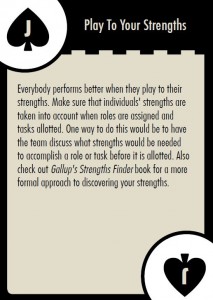What are the chances of you being actively disengaged when your manager primarily:
- ignores you
- focuses on your weaknesses
- focuses on your strengths
Drum roll please …40%, 22% and 1% respectively according to a 2005 Gallup poll. Translated, that means to me that managers who are too busy to spend any time with their employees are at risk of them being 40% less productive … that’s pretty staggering. In my experience this stat translates equally well with teams. Those teams who focus on and play to their respective strengths are highly engaged, productive and enjoy their teams. Those teams who ignore the conversation about strengths and/or do not ever revisit roles run the risk of losing momentum and energy.
The best resource we’ve seen about uncovering strengths is StrengthsFinder 2.0, developed by Tom Rath and based on years and years of Gallup research. The most powerful aspect of this framework is its definition of strengths – those activities we find energizing. Most of us think of strengths as the things we are good at … seeing strengths as those things that energize us is a subtle but powerful shift.
So how does a team go about exploring strengths in a structured and meaningful way? Here’s what we suggest:
- Each member buy the StrengthsFinder 2.0 book, complete the online assessment, and read the customized report. Amazon online has it available for $15 per book, a great deal!
- Set aside 2 -3 hours (depends upon the size of your team) at a next team meeting to work with the results.
- Draw up a big wall chart … listing the 34 strengths horizontally across the top and team member names vertically along one side.
- Each team member then places an x in each of their strengths.
- Based on the results, organize your team into groups of 2 people, each group of 2 exploring a shared strength by identifying what it means to them and some concrete examples of the strength.
- After the report out, have a broad discussion of the team’s strengths.
- Then, list all of the projects your team is engaged in and identify the strengths most needed in those projects.
- Finally, have a conversation about roles/accountabilities … are the right people doing the right things? Can you shift your team work to more readily accommodate team strengths?
We have facilitated this activity with dozens of teams and are inspired by the conversations that people have and the level of excitement and engagement. It is one of the most useful tools we have seen to protect a team from disengaging, or to put it more positively, Play to your Strengths, our teamwork tip of the week.

Jack of Spades – Play to your Strengths
Everybody performs better when they play to their strengths. Make sure that individuals’ strengths are taken into account when roles are assigned and tasks allotted. One way to do this would be to have the team discuss what strengths would be needed to accomplish a role or task before it is allotted. Also check out Gallup’s Strengths Finder book for a more formal approach to discovering your strengths.
What % of time do you think your team is playing to its strengths? What might happen if you increased that by 10%?
Would you like more help re-engaging your team? We offer customized teambuilding and team coaching experiences. Contact us today for a free consultation.